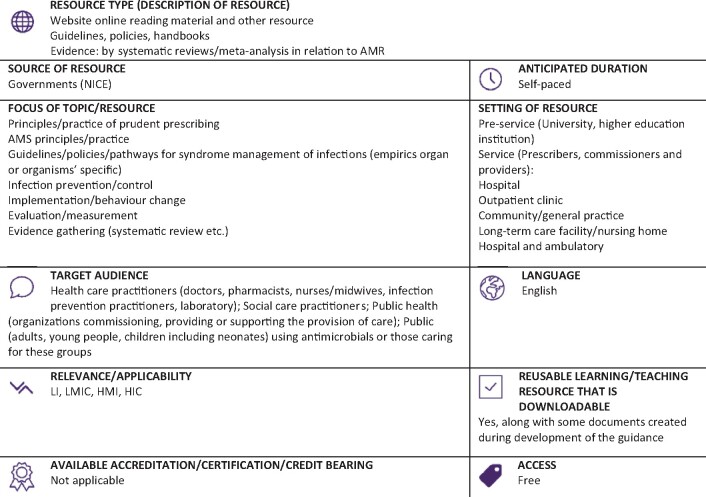Graphical Abstract
Graphical Abstract.
LI, low-income countries; LMIC, low- and middle-income countries; HMI, high- and middle-income countries; HIC, high-income countries.
Resource web link: https://www.nice.org.uk/guidance/ng15 (Full classification scheme available at: http://bsac.org.uk/wp-content/uploads/2019/03/Educational-resource-review-classification-scheme.pdf)
WHO region and country (World Bank): Europe, UK (HIC)
Peer review commentary
This is a very useful and valuable guide offering summarized best practice advice on the effective use of antimicrobial medicines applicable for every setting, country or person, as everyone needs an antimicrobial at some time in their life. Containing concrete recommendations for healthcare practitioners, prescribers, social care practitioners and organizations (commissioners and providers) this guideline has a prospective educational and practical effect. All recommendations are based on the trade-off between the benefits and harms of an intervention, taking into the account the quality of the underpinning evidence. What is more, this resource also provides tools for implementing these recommendations into practice and how to access and evaluate these actions. For better motivation for starting implementation of antimicrobial stewardship programmes, it has information showing the actual numbers and effects of the uptake of this guidance. It also contains links for related topics and further learning. Published in 2015 the guideline has had minor changes since publication with the last update of some links to other guidelines and external sources of information in January 2018.
The content is available both for online reading and for downloading. There are different versions of the guidelines to better meet the needs of each potential target audience, a ‘short’ version listing a summary of recommendations, an ‘information for the public’ written for people without special medical education and a ‘full guideline’ containing recommendations and details of the methods used and the underpinning evidence. It is worth noting this guidance does not cover specific clinical issues on antimicrobial use, pharmacology of antimicrobials or infection prevention. Nevertheless, systems and processes described here proved to be a very good tool for better use of antibiotics in order to reduce antimicrobial resistance.



